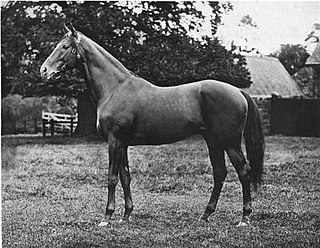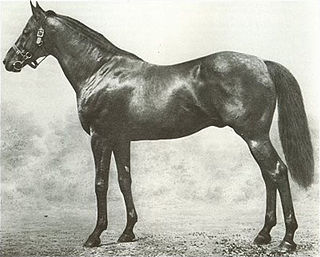Related Research Articles

The Flying Dutchman (1846–1870) was an English Thoroughbred racehorse and sire. He raced for four seasons between 1848 and 1851, winning all but one of his fifteen races, including The Derby and the St Leger. On his final racecourse appearance he defeated Voltigeur in what was probably the most celebrated match race in the history of British thoroughbred racing, known as The Great Match. He went on to be a success at stud both in Britain and France, where he died in 1870. The Flying Dutchman was regarded by experts as one of the greatest British racehorses of the nineteenth century.

Colorado (1923–1929) was a British Thoroughbred racehorse and sire. He won the 2000 Guineas in 1926 and the Eclipse Stakes in 1927. He was also noted for his rivalry with the Derby winner Coronach whom he defeated on three of their four meetings.

Diamond Jubilee was a British-bred and British-trained Thoroughbred race horse and sire. In a career which lasted from June 1899 until October 1901 he ran sixteen times and won six races.

Lemberg (1907–1928) was a British Thoroughbred racehorse and sire. He won seventeen times in a career that lasted from 1909 until 1911, taking major races at two, three and four years of age. Lemberg won his most important victory as a three-year-old in 1910 when he won The Derby. His career was marked by his rivalries, first with the fast and precocious Neil Gow and later with the outstanding middle-distance runner Swynford. Lemberg went on to have a successful career at stud.

Tagalie (1909–1920) was a British Thoroughbred racehorse. She was one of only six fillies to win The Derby, and was also the second of only four greys to have won the race. She achieved this feat as a three-year-old in 1912, a year in which she had already won the 1000 Guineas. Although her Derby win was easy and impressive, she failed to reproduce her winning form in her three subsequent races.

Cicero (1902–1923) was a British Thoroughbred racehorse and sire. He was the best English two-year-old of 1904, winning all five of his races. In 1905 Cicero became one of the shortest priced successful favourites in the history of the Derby, winning at 4/11 to remain undefeated. He won only once from his remaining three races before retiring to a modestly successful career at stud.
Sansovino (1921–1940) was a British Thoroughbred racehorse and sire. In a career which lasted from 1922 to 1924 he ran twelve times and won six races. His most significant victory came as a three-year-old in 1924 when he won The Derby by six lengths in some of the most difficult conditions in the race's history. He went on to have a modestly successful career at stud.

St. Amant (1901–1920) was a British Thoroughbred racehorse and sire. In a career that lasted from 1903 to 1906, he ran twenty-one times and won six races. As a three-year-old in 1904, he won both the 2000 Guineas Stakes and the Derby, but he failed to win the English Triple Crown when he was well beaten in the St. Leger by the filly Pretty Polly. He was kept in training for two more seasons but won only one more race before being retired.

Jeddah (1895–1909) was a British Thoroughbred racehorse and sire. In a career that lasted from 1897 to 1899 he ran nine times and won three races. In the summer of 1898 he became the first horse to win The Derby at odds of 100/1, and followed up by winning the Prince of Wales's Stakes at Royal Ascot. He was retired to stud after a single, unsuccessful race in 1899, but had serious fertility problems and made no impact as a stallion.

Common (1888–1912) was a British Thoroughbred racehorse and sire. In a career that lasted from May to September 1891 he ran five times and won four races. He became the fifth, and the most lighty-raced horse to win the English Triple Crown by winning the 2000 Guineas at Newmarket, the Derby at Epsom and the St Leger at Doncaster.

Sir Hugo (1889–1910) was a British Thoroughbred racehorse and sire. In a career that lasted from 1891 to 1894 he ran eight times and won three races. As a three-year-old in 1892 he won The Derby at odds of 40/1. He was a consistent performer in top class races, but certainly inferior to his contemporaries Orme and La Fleche.

Donovan (1886–1905) was a British Thoroughbred racehorse and sire. In a career that lasted from 1888 to 1889, he ran twenty-one times and won eighteen races. He was the leading British two-year-old of 1888 when he won eleven of his thirteen starts. At the age of three Donovan won The Derby and the St Leger: he failed to win the English Triple Crown owing to a narrow and probably unlucky defeat in the 2000 Guineas. He set a world record by earning a total of £55,443 in win prize money. Donovan was a modest success as a stallion. He died after being injured in an accident in 1905.

Merry Hampton was a British Thoroughbred racehorse and sire. In a career that lasted from 1887 to 1888 he ran four times and won once in a career that was restricted by injuries and training difficulties. His sole victory came on his racecourse debut when he won the 1887 Epsom Derby as an 11/1 "dark horse". He never won again but did finish second in the St. Leger Stakes at Doncaster. He was retired to stud after a single start as a four-year-old in which he aggravated a chronic leg injury.

Ayrshire (1885–1910) was a British Thoroughbred racehorse and sire. In a career that lasted from 1887 to 1889 he ran sixteen times and won eleven races. After winning five races as a two-year-old he became the leading British three-year-old colt of 1888 when he won the 2000 Guineas at Newmarket and the Derby at Epsom. He failed in his bid to win the English Triple Crown when beaten in the St Leger at Doncaster but returned in 1889 for a successful campaign which included a win in the Eclipse Stakes at Sandown. He was retired to stud at the end of the year and had a modestly successful career as a stallion. He died in 1910.

Harvester (1881–1906) was a British Thoroughbred racehorse and sire. In a career that lasted from 1883 to 1884 he ran thirteen times and won five races. In 1884 he was involved in the second, and most recent dead heat in the history of The Derby. At the end of his racing career, Harvester was sold and exported to stand as a stallion in Austria. He died in 1906 in Hungary.

Surplice (1845–1871) was a British Thoroughbred racehorse and sire. In a career that lasted from July 1847 to October 1849 he ran thirteen times and won nine races. He was the leading colt of his generation in England at both two and three years old, with his wins including The Derby and the St Leger in 1848: he was the first horse for forty-eight years to win both of these Classics. His later career was less successful and he was retired to stud in 1850. Surplice had limited success as a sire of winners and died in 1871.
Desmond was a British Thoroughbred racehorse and sire. He was at his peak as a two-year-old in the early summer of 1898 when he won three races in quick succession including the Coventry Stakes and the July Stakes. He never won again and was retired from racing at the end of the following year. He later became a very successful breeding stallion and was the Leading sire in Great Britain and Ireland in 1913, the year of his death.
Udaipur was a British Thoroughbred racehorse and broodmare. Her racing career consisted of eight races between April and October 1932. Having finished second on her debut and seventh in the 1000 Guineas she was still a maiden when she recorded her biggest win in the Epsom Oaks in June. She went on to win the Coronation Stakes, Richemont Stakes and Newmarket Oaks as well as finishing fourth in a strong edition of the St Leger. As a broodmare she produced several good winners and was the female-line ancestor of Wild Again.
Chatelaine (1930–1937) was a British Thoroughbred racehorse and broodmare. After failing to win in her first seven races she was still a maiden when she recorded a 25/1 upset victory in the Epsom Oaks. She went on to win the Scarbrough Stakes and dead-heated for the Champion Stakes as well as finishing second in the Jockey Club Stakes and finishing third in the Coronation Cup. She was retired to become a broodmare but died in 1937 after producing only two foals, neither of which survived.
Pennycomequick was a British Thoroughbred racehorse and broodmare. She showed promise as a two-year-old in 1928 when she won her only race by a wide margin. In the following year she won two races including a victory in the Epsom Oaks. She failed when made favourite for the St Leger and was retired from racing after sustaining a serious leg injury in autumn. She became a very successful broodmare, producing several major winners.
References
- 1 2 "Kingsclere". paperspast.natlib.govt.nz. Ogago Witness. 6 April 1888. Retrieved 2 January 2021.
- ↑ "Mr John Porter". paperspast.natlib.govt.nz. Press. 9 June 1890. Retrieved 2 January 2021.
- ↑ "About the Cesarewitch". paperspast.natlib.govt.nz. Evening Star. 1 December 1888. Retrieved 2 January 2021.
- ↑ "Baily's Magazine of Sports and Pastimes". Vinton. 1889. Retrieved 2 January 2021.
- ↑ "Turf Notes". paperspast.natlib.govt.nz. Wairarapa Daily Times.
- ↑ "Leading Sires of America". www.tbheritage.com. Retrieved 2 January 2021.
- ↑ "Turf Notes". paperspast.natlib.govt.nz. Wairarapana Daily Times. 7 January 1905. Retrieved 2 January 2021.
- ↑ "ROSEBEN, CHAMPION SPRINTER, IS DYING. Ben Strome Gelding Lowered Six-Furlong Mark to 1:11 3-5 and the Seven-Furlong Record to 1:22". The New York Times. 20 September 1907. Retrieved 2 January 2021.
- ↑ "BELMONT'S ST. BLAISE DEAD". The New York Times. 16 October 1909. Retrieved 2 January 2021.
- ↑ "Pedigree of Ben Strome". Equineline. Retrieved 2 January 2021.
- ↑ "Thoroughbred Bloodlines - The Oldfield Mare Mare - Family 14". www.bloodlines.net. Retrieved 2 January 2021.